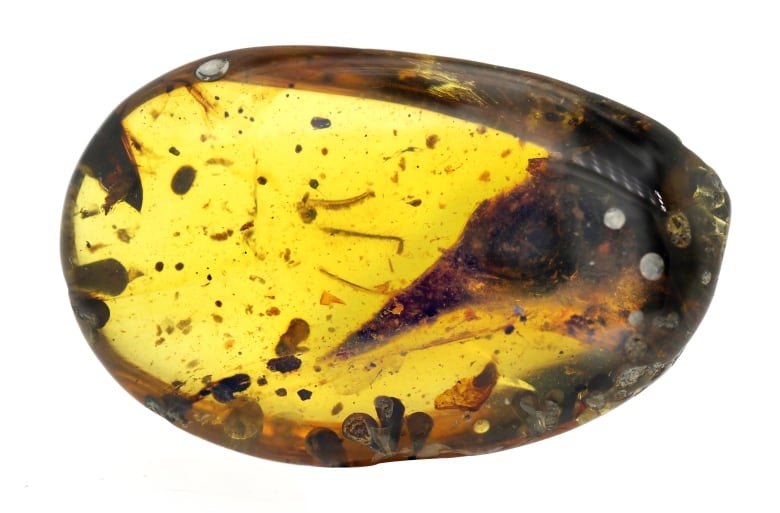Smallest dinosaur ever found was hummingbird-sized
Tiny bird-like dino found trapped in amber had teeth in beak and claws on wings

A bird-like dinosaur with a beak full of teeth and claws on its wings is the tiniest extinct dinosaur ever found.
The dinosaur's beautifully preserved skull — about as long as your thumbnail from the tip of its beak to the back of its head — was found in a hunk of amber from northern Myanmar, researchers report in a new study published Wednesday in Nature.
Its brain is a little smaller than that of the bee hummingbird, the smallest living bird, said Ryan McKellar, a Canadian paleontologist who co-authored the study with Chinese, Canadian and U.S. researchers. "But once you include the snout, you're talking about something that's about the same size."
Technically, the bee hummingbird is a dinosaur itself, as all modern living birds are, making the new species the smallest extinct dinosaur.
Despite being so tiny, the bones in its skull have fused together, indicating that it's an adult or near adult.

It lived about 99 million years ago in what was then a tropical mangrove forest teeming with insects, frogs, salamanders, lizards and other bird-like dinosaurs — though they had not yet evolved completely to resemble modern birds.
"They're sort of our neat little guys that scurried around on tree trunks … that still had claws in their wings and still had teeth in their snout," said McKellar, curator of paleontology for the Royal Saskatchewan Museum in Regina.
Where its name came from
In fact, this particular animal's teeth were unusual. Unlike most birds at the time, who had teeth just on the tips of their beaks, it had dozens that extended close to the back of its mouth under its eye. For that reason, the new species was named Oculudentavis khaungraae.
The first part of its name means "eye-teeth-bird," while the second part of its name honours Khuang Ra, the woman who bought the fossil at a market and donated it to the Hupoge Amber Museum in China where it could be studied.
McKellar says this particular bird would likely have been adapted to eat insects and snails. Its large, lizard-like eyes were adapted to narrowing its pupil in bright light, suggesting it was active during the day. They're also pointed more sideways than forward compared with modern birds.
"So [it was] maybe even better adapted for escaping as prey as opposed to actually hunting things," he added.
The study was led by Lida Xing, an associate professor at the China University of Geosciences in Beijing who previously studied and worked in Canada, and Jingmai O'Connor, a paleontologist at the Institute of Vertebrate Paleontology and Paleoanthropology in Beijing.

O'Connor said in the email that the discovery shows how small dinosaurs could be, and that even ones this tiny could be predators — something that wasn't known before.
McKellar got involved in the project a couple of years ago while collaborating with Xing on a different study, and was tasked with figuring out how the animal became encased in amber. It appears the bird was already dead — though freshly so — and rather wet when it became trapped in sticky, syrupy amber oozing down a tree trunk. The types of insects trapped with it suggest the amber never made it to the forest floor before hardening.
Amber's advantage over fossils
He said the special thing about amber is it provides a snapshot of animals so small that they're rarely preserved as fossils. Most dinosaur fossils are the size of crows or larger. In this case, Oculudentavis is even smaller than other birds found in Myanmar amber, which are usually about the size of sparrows or robins.
In this case, none of Oculudentavis's feathers were preserved, as its skin got separated from its skull during decomposition.

But McKellar said Myanmar amber is also key to figuring out the origin of feathers trapped in Canadian amber found in Alberta and Saskatchewan.
While about 10 tonnes of amber are mined for jewelry each year in Myanmar, Canada produces only about a kilogram a year "and the pieces are smaller and more fragile," McKellar said.
By comparing the feathers found in those pieces to larger pieces with more body parts found in Myanmar, scientists are able to learn more about the feathered dinosaurs that lived in Canada.